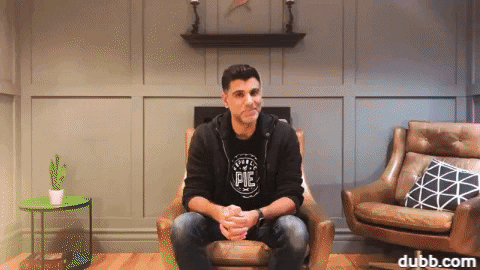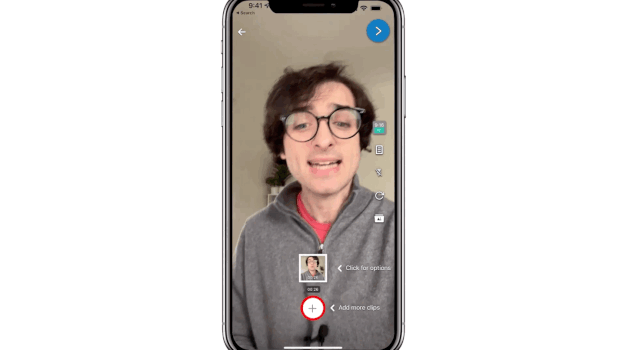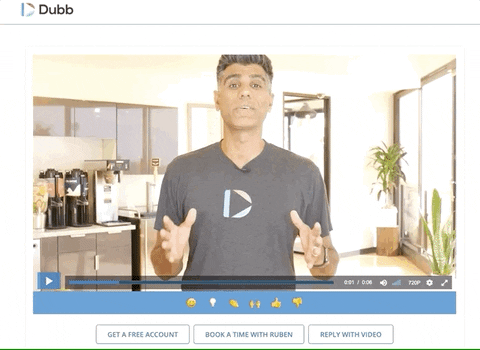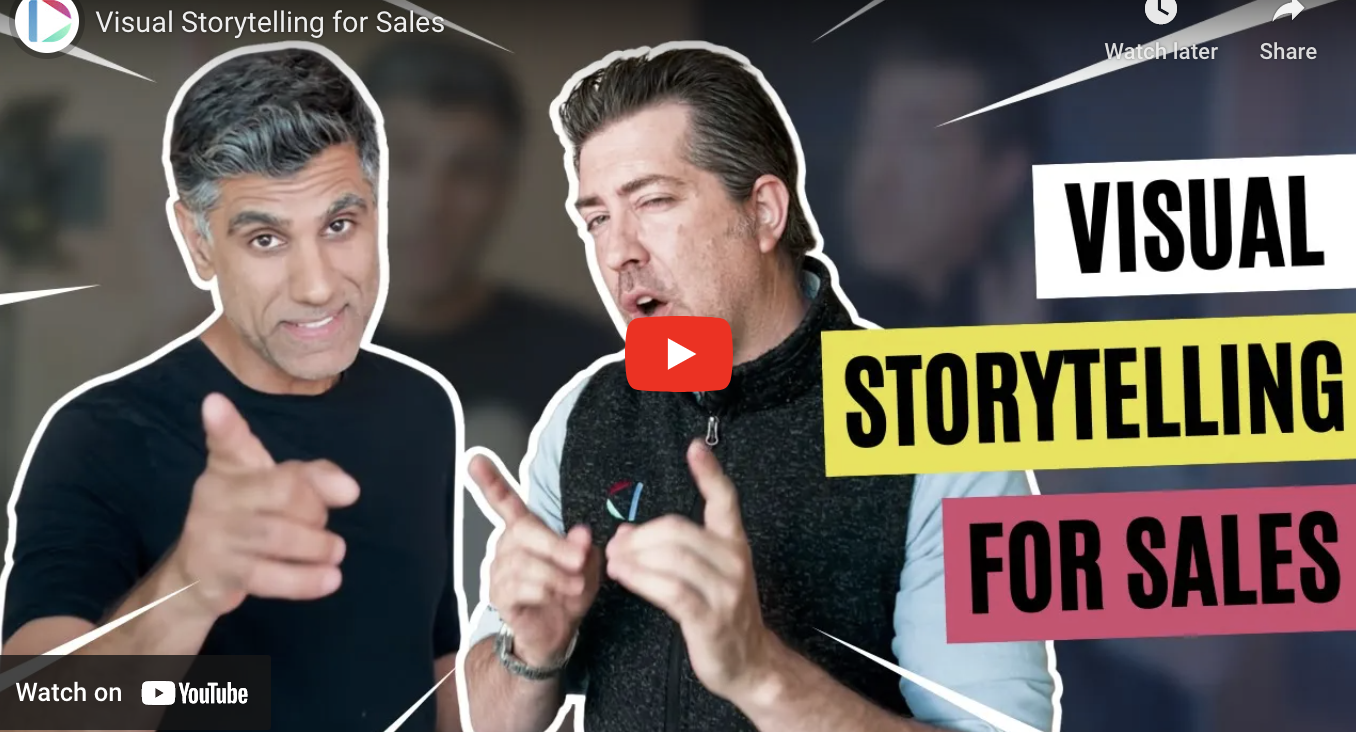In this recap from a recent episode of RevShow, Rob and I discuss some of the best ways that you can leverage visual storytelling for sales. Whether you are a brand new member of a sales team or have been leading your sales department for some time, you can definitely rely on these tips and tricks to accomplish your sales goals. If you want to watch the episode in its entirety, go ahead and click on the video above. Happy learning!
Are you in sales and are sick of being ignored? Are you tired of having your LinkedIn messages, calls, and emails discarded and thrown to the side? What is the solution here?
As you can guess, the answer is visual storytelling for sales.
Visual storytelling is a fantastic way to build strong connections with any type of audience. By creating those strong connections, you can substantially increase your chances of making more sales. Even though it may seem like a less direct sales strategy than cold calling a prospect and directly asking for a sale, visual storytelling is a much more effective strategy for hitting your sales goals.
In this post, we are going to take a deep dive into visual storytelling for sales. We are going to discuss everything from why visual storytelling is so effective to the “Six Cs” that can help you tell the best possible visual stories. You are going to find a lot of value here, whether you are struggling to hit your sales objectives or want another way to find even more sales.
Are you ready? Let’s jump into it and learn all about the power of video.
Why Visual Storytelling is So Important
To kick off this discussion, I want to spend some time talking about why visual storytelling is so important. While you may have used video before (whether it was in a personal or professional setting), I think it’s important to speak about the basics before we delve into how to get the most out of visual storytelling for sales.
At Dubb, we constantly speak with sales professionals. The number one challenge that we hear is that they want to punch through the noise. In other words, they want to find a way that can differentiate themselves from other sales professionals. Their goal is to capture people’s attention and to actually get a response to their email or SMS message. Moreover, they want the prospect to be delighted to hear from them.
Considering all of this, I strongly believe that visual storytelling is one of the most effective ways to accomplish these goals. Here is what I mean by this. You don’t need to go to film school to get the most out of visual storytelling. Instead, with simple technology, you can record multiple clips, add dynamics, and convey a visual story. You can do all of this with just a few clicks on your smartphone, making it an extremely compelling way of communicating with any type of customer or prospect.
So why do we want to convey a visual story? Ultimately, people connect to stories. This is true whether the stories are personal stories or stories that they heard about on the news or social media. Stories let us gather together and say, “You know what? I can relate to that.” However, in this discussion, we aren’t simply talking about stories. We are talking about visually compelling stories.

At Dubb, the one thing we like to say is “create an experience, not an exercise.” When you actually create a video and send it in a creative manner (which we will discuss in more detail), you are creating a strong connection with your audience. By contrast, if you are not doing this, you are simply moving forward with a sales exercise. These sales exercises have been seen one thousand times before, so they aren’t going to help you stand out and get you those sales that you are aiming for.
And guess what? Visual storytelling will awaken your audience’s senses. Their minds will be triggered by things like curiosity, compassion, and empathy. For instance, if you send a Dubb video email to a specific prospect, their mind will be compelled and inspired to click on the animated GIF that is created for every Dubb video email. They will be compelled to watch the video and, most importantly, connect with you.
Five Levels of Research
Now, before we get into the actual creation of your sales videos, you need to think about how to start. One good way is to start with some research.
That leads to a natural question, however. That question is: what are some of the ways that we can research our prospects before reaching out?
The good news is that there are five different levels of researching and reaching out to prospects. I like to categorize them from level 101 to level 501. As you will see, the levels go from the most basic to the most advanced.
At the most basic level (the 101 level), you can go to that prospect’s social media accounts. You can visit their LinkedIn page, Facebook profile, Twitter account, or some other type of online social account. From there, you can learn more about the prospect and what they are all about. Then, you can create a screen recording video with the prospect’s background behind you. This is an easy, visual way to show that you recognize the prospect as a person and that you are genuinely interested in solving the problems or dilemmas that they have in their life. The reason why we call the social media profile outreach a “101 level” outreach is that it represents a basic level of outreach. Through doing this preliminary research, you can start building a connection with that prospect.
This 101 level type of outreach only goes so far, however. The next level is “201 level” outreach. With this type of communication, you are acknowledging the prospect’s skills, interests, and passions. An example is helpful here. Let’s say that you are reaching out to a cartoonist. You could make a video for that cartoonist and include one of the prospect’s cartoons in your video. You can say something like, “I loved your cartoon.” From there, you could transition into the real reason why you reached out to the prospect. This is a nice way to approach a sales interaction. You aren’t just acknowledging that the prospect exists. You are going one step further and saying, “Wow, I really appreciate your talent. I can relate to your cartoon for this and that reason.” This type of interaction is much more meaningful than 101 level outreach.
As another example, let’s say that you look at a prospect’s profile and see a sports team that you like. Mentioning that team and your feelings toward them is really meaningful. Think about it: the reason that people put those kinds of things on their profiles is because it means something to them. If they are posting about sports, life, or whatever interest they have, it is because they are genuinely enthusiastic about that topic. So if their interest relates to your interest, that is gold. You aren’t just commenting on something where you don’t have any connection or commonality. Instead, you are saying, “I see that and I can relate to that.”
Let’s talk about the third level (301 level outreach). 301 outreach is all about the give, not the get. Let’s jump back to the cartoon and sports team examples. Let’s also assume that what you are selling isn’t related to those topics. However, what if you have a piece of educational material that you found online and that you think the prospect would love? If your prospect is a fan of the Boston Celtics, you may want to send them an article about a player that the Celtics may draft. That is a give. You’re not expecting anything in return. Rather, you are signaling that you recognize that this piece of content may be valuable and you are giving that content to them.
The wrong move here would be the get. In this situation, you would be sending something to the prospect and expecting something in return. Continuing with the Celtics example, you could be sending the prospect a few lattes for the next time the prospect goes to a Celtics game. The prospect may feel indebted and that they should meet you before or after the game (likely to talk about what you want to sell them). That is not the idea here. You want to emphasize the give over the get.
Let’s discuss one more example. Let’s assume you are sending a PDF of a sales deck to a prospect. If you simply send that sales deck to the prospect, you’re really not asking for permission. You are sending that deck expecting them to respond and book a time with you. That’s just not the way to go. Ultimately, the revenue is in the research and by giving, not getting. Keep this in mind as you begin to leverage visual storytelling for sales.
From 301 level outreach, let’s talk about 401 level outreach. 401 level outreach is all about automation. I believe that automation is the final frontier of sales. I know what you may be thinking: automation isn’t exactly the most research-driven or personalized sales effort. You’re probably right about that. The point, however, is that not everyone is going to get back to you right after you send them a message. Some prospects need a little more time. They may be really busy or may be going through something in their personal lives. Ultimately, they may need some time to consume your message and eventually get back to you.
Considering all of this, why not enter them into an automated workflow? What about a smart sequence? By doing this, you can send them email drip messages of content that they want to hear. This can be things like case studies, testimonials, or educational videos where you can help them solve their problems. And who knows? Eventually, you may end up going with them to a Celtics game.
While the 401 level outreach took years to come up with, there is a bonus here. I’m talking about 501 level outreach. 501 is all about making this entire process scalable and repeatable. This phrase “scalable and repeatable” is something that I constantly mention. I do it because it is so important. If you can develop a sales process that is scalable and repeatable, the sky is the limit. Incorporating the outreach steps above and leveraging automation gets you extremely close to this type of sales nirvana. Even when you are sleeping, your scalable and repeatable sales process can interact with prospects and get you much closer to making sales. Granted, it takes some time to reach this 501 level outreach. However, it is attainable, so definitely work towards it. You may be surprised at what happens.
These five levels of research and outreach are fantastic ways to learn more about your prospects. Whether you just met a prospect at a conference or had a prospect organically reach out to your company, you can rely on any (or all) of these levels of outreach to start building those connections.
The Power of Storyboarding
Once you have done some research into your prospects, you are going to want to move on to the next step in leveraging visual storytelling. Here, I am talking about creating a storyboard.
While creating a storyboard may sound intimidating, it is really just about putting your thoughts down on paper (or your computer). It can be jotting down a little sketch of the overall story or a few blocks that comprise each element of the story.
Let’s jump into another example. Assume that I am a car salesman and I am reaching out to a prospect. Before shooting a video for that prospect, I’m thinking about ways to create a valuable, relevant video that engages them right from the start. Considering this, the first shot of my video could be me showing some car keys. It could be me showing a handshake or sitting in a car and showing off a particular feature. Essentially, you can include something that can really pop in the first three seconds of your video. Not only do you want to immediately capture the prospect’s attention, but you want a compelling first three seconds so that it can be displayed in the animated GIF that Dubb automatically creates.
Then, in the actual video itself, I can transition to my face and say something like, “Hey, I’m here at the dealership and just want to share some of the deals that we have going on right now. The features in this car are amazing and one of the features you are going to enjoy is this one.” Keep the video itself under 30 seconds.
There is another critical point here. The whole idea here of visual storytelling is to show them something. Within the first clip, you want to have a really engaging visual clip. Instead of trying to figure out that clip on the fly, it is much easier (and more effective) to do so through a storyboard. It’s really the same principle as putting forth a strong first impression. A strong first impression makes it much easier to build a robust long-term relationship. On the other hand, a weak first impression makes your job that much harder (if not impossible).
Ultimately, don’t hesitate to storyboard before recording your sales videos. It will make your videos that much better and will increase your chances of getting a conversion.
Why You Should Be Recording Clips
Storyboarding is a hugely helpful way to create the best possible sales videos. I would definitely spend time on this step. After you have storyboarded, I recommend that you start recording in clips. This is one of the easiest ways to leverage visual storytelling for sales.
To reiterate, by creating visual stories, you are in a much better position to sell your product or service. We have seen the proof countless numbers of times with thousands of different sales teams. The greatest thing about this is that it is extremely easy to record your videos. By recording multiple clips as part of your overall video, you are building a visual story. You are essentially creating a movie that helps your audience feel something. And when your audience feels something? They are more open to working with you.

At Dubb, we suggest that you start recording video content for your prospects. Get some practice and utilize the tips that we mentioned above. Through practice, you will get more replies, more bookings, and more conversions. Our team has invested so much time and effort to help you create awesome sales videos through the Dubb mobile app (you can find it on iOS and Android). By using the Dubb mobile app, you can record multiple clips, add music, add voiceovers, and add text overlays so you can tell visual stories to capture people’s attention.
But let’s get back to shooting video in clips. Shooting in clips or scenes is like bringing a storyboard to life. Each frame in your video is part of the storyboard. For instance, when we use the Dubb mobile app, we hit record, speak, stop, start a new clip, and continue the process until the video is finished. You can play with different angles and collect your thoughts before continuing to record. Once you have recorded all of your clips (and you have been very intentional with your shots), you can then move the clips around. If you storyboarded properly, you may not need to move them around. But if you haven’t, no big deal. With the Dubb mobile app, you can easily do so.
The whole idea here is to create a mini-movie in a simple format. All of this work is done with the ultimate objective of connecting with that prospect. So whether you use Dubb or some other mobile app, use the clips feature. This is monumentally important to leveraging visual storytelling for sales.
The Six Cs
I think the key when leveraging visual storytelling for sales comes down to six Cs. Those six Cs are capture, convey, provide a call to action, connect, converse, and convert. These six Cs will help you accomplish your sales goals, whatever they are. They can help you with everything from leading your prospects down a sales funnel or bringing your prospects across the conversion line. To better understand what these Six Cs are, let’s spend some time on each one.
With capturing, you are recording the clips that you will use in your sales video. This is essentially what I was discussing above. You are putting in the work to create a value-added sales video for a prospect or prospects. If you get into the habit of capturing video content, you’ll find that you have plenty of awesome visuals that you can use in your sales videos. When in doubt, pull out your camera and start recording.
Stage two (convey) is all about articulating your message. In other words, it is communicating the fact that you have done your research on that person, that you have something interesting to say, and that you have a solution to a problem that they are facing in their life. In other words, it’s about showing that you empathize with the other person and want to genuinely add value to their life.
Stage three is all about providing a call to action. Simply put, without a call to action, people don’t know what to do. They won’t know how to advance the conversation, and in the worst situations, it may mean that you have lost a sale. The great news is that Dubb users can access so many calls to action for their video landing pages, including reaching out through Facebook Messenger, directly scheduling a call on your calendar, downloading a file, replying to your video with a video of their own, and even making a purchase. Calls to action are extremely important parts of leveraging visual storytelling for sales, so make sure that you are including them with every video you create. With Dubb, the great news is that you can create video landing page templates, meaning that you can include effective calls to action on every one of your Dubb videos. This not only makes your job easier, but it helps you get that much closer to a conversion.

Now, let’s talk about stage four (which is making a connection). You already know how to do this. There are plenty of ways that you can make a connection (both in real life and in digital form). For instance, you can meet with the prospect one-on-one. You can invite them to a webinar or even get them to complete a form. Whatever you choose, focus on making that connection. Even if you don’t pitch them on your product or service right now, building a connection can drastically increase your chances of making a sale.
Stage five is about conversing. Once you have made that connection, you can now start building a relationship. Time is your friend, here. Often, it is going to take time to build a strong relationship with a prospect. You need to be patient and continuously provide value. Keeping this in mind can help you as you continue conversing with your prospects.
Finally, step six is about the conversion. When you tell a visual story, give your audience a branded experience. Don’t expose your sales exercise. Remember that when you are telling that story, show and don’t tell. Doing all of this puts the odds on your side and makes it much more likely that you will actually get that conversion.
Go Forward and Leverage Visual Storytelling For Sales
Granted, the process of researching your prospects and creating visual stories for them takes some time. However, by investing time into this process, you can expect to see a very high conversion rate. This is because your audience will actually feel something. They will realize that you put in the time to learn about them and that you are an interesting person to connect with.
So if you want to broadcast video messages in the form of email or SMS campaigns, think about creating a story arc (essentially, a before and an after). Make sure that you are sharing the desired outcome and the solution that your product or service provides. Incorporating this type of story arc is a compelling way to show how your company can make your viewers’ lives better. Along with this, don’t hesitate to incorporate the advice and tips above. Visual storytelling is a fantastic (and fun) way to show off your creativity and grow your business. I can’t wait to see what you create!
At Dubb, we love talking about topics like how to leverage visual storytelling for sales. If you have any questions about this post or want to learn more about how to create great video content for your prospects and customers, reach out by clicking here. You can also click here to learn more about Dubb and click here to get a free 14-day trial of our premium plans.


